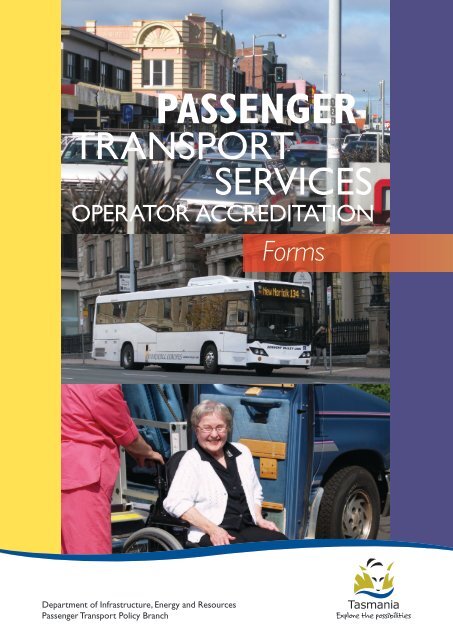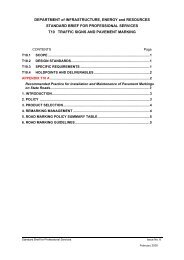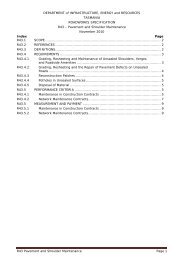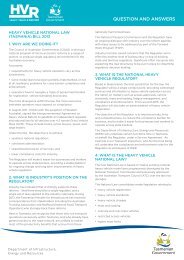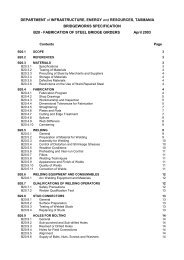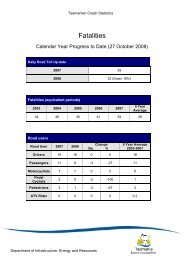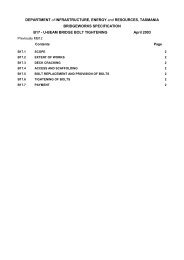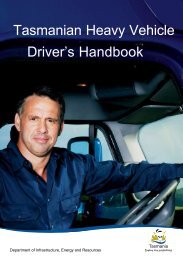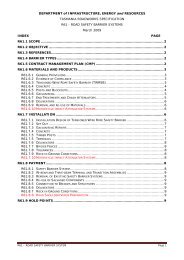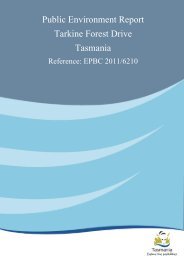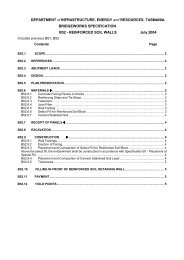Operator Accreditation Manual - Forms - Transport
Operator Accreditation Manual - Forms - Transport
Operator Accreditation Manual - Forms - Transport
Create successful ePaper yourself
Turn your PDF publications into a flip-book with our unique Google optimized e-Paper software.
PASSENGER<br />
TRANSPORT<br />
SERVICES<br />
OPERATOR ACCREDITATION<br />
<strong>Forms</strong><br />
Department of Infrastructure, Energy and Resources<br />
Passenger <strong>Transport</strong> Policy Branch
Produced by<br />
Passenger <strong>Transport</strong> Policy Branch<br />
Department of Infrastructure,<br />
Energy and Resources<br />
GPO BOX 936<br />
Hobart Tasmania 7001<br />
Phone 03 6233 5347<br />
Email: operator.accreditation@dier.tas.gov.au<br />
This manual is available online at:<br />
www.transport.tas.gov.au/operator_information
STANDARD/<br />
FORM<br />
DOCUMENT<br />
1.4 Register of vehicles<br />
2<br />
• General vehicle register<br />
• Taxi and luxury hire car register<br />
2.2 Pre-departure checklists<br />
4<br />
• Bus (regular use)<br />
• Bus (occasional use)<br />
• Taxi (regular use)<br />
• Taxi (occasional use)<br />
• Small passenger vehicle (regular use)<br />
• Small passenger vehicle (occasional use)<br />
2.2A Record of daily inspections 10<br />
2.3 Fault and clearance report 11<br />
2.5 Emergency management procedures 12<br />
3.2 Register of drivers<br />
13<br />
• Taxi and luxury hire car<br />
• Other passenger transport services<br />
3.3 Driver monitoring 15<br />
3.4 Passenger behaviour management procedures 16<br />
3.5 Reportable incident management procedures 21<br />
Passenger <strong>Transport</strong> Services <strong>Operator</strong> <strong>Accreditation</strong> <strong>Forms</strong> 1
Passenger <strong>Transport</strong> Services <strong>Operator</strong> <strong>Accreditation</strong> <strong>Manual</strong> Form 1.4<br />
FORM 1.4 Register REGISTER of OF Vehicles VEHICLES<br />
This form sets out the minimum information that you are are required to to keep for for each each vehicle for for accreditation.<br />
You may wish to create a more detailed form that includes<br />
additional<br />
information<br />
information<br />
on the type<br />
about<br />
of vehicle,<br />
the vehicles,<br />
the operational<br />
such as<br />
the date and place of purchase and the due date for replacement.<br />
capacity of each vehicle, the date it is due for replacement and the date and place of purchase.<br />
Vehicle<br />
number/<br />
identifier<br />
Registration<br />
number<br />
Registration<br />
expiry<br />
Vehicle make/model<br />
Seating/<br />
operational<br />
capacity<br />
Manufacture<br />
date (mm/yy)<br />
First inspection<br />
due (refer to<br />
Standard 2.1)<br />
Second<br />
inspection due<br />
(if relevant –<br />
refer to<br />
Standard 2.1)<br />
2 Passenger <strong>Transport</strong> Sevices <strong>Operator</strong> <strong>Accreditation</strong> <strong>Forms</strong><br />
Vehicle Register – Passenger <strong>Transport</strong> Service
Vehicle Register – Taxi and Luxury Hire Car<br />
Passenger <strong>Transport</strong> Services <strong>Operator</strong> <strong>Accreditation</strong> <strong>Manual</strong> Form 1.4<br />
FORM 1.4 Register REGISTER of OF Vehicles VEHICLES<br />
(TAXI AND LUXURY HIRE CAR)<br />
(taxi and luxury hire car)<br />
This form sets out the minimum information that you are required to keep for each vehicle for accreditation.<br />
You may wish to create a more detailed form that includes additional information about the vehicles, such as<br />
the date and place of purchase and seating capacity.<br />
This form sets out the minimum information that you are required to keep for each vehicle for accreditation.<br />
You may wish to create a more detailed form that includes information on the type of vehicle, the operational<br />
capacity of each vehicle, and the date and place of purchase.<br />
Vehicle<br />
number/<br />
identifier<br />
Registration<br />
number<br />
Registration<br />
expiry<br />
Vehicle make/<br />
model<br />
Seating<br />
capacity<br />
Manufacture<br />
date (mm/yy)<br />
Date from<br />
which vehicle<br />
can no longer<br />
be used as a<br />
taxi/luxury hire<br />
car<br />
First<br />
inspection due<br />
(see Standard<br />
2.1)<br />
Second<br />
inspection due<br />
(if relevant: see<br />
Standard 2.1)<br />
Passenger <strong>Transport</strong> Services <strong>Operator</strong> <strong>Accreditation</strong> <strong>Forms</strong> 3
FORM 2.2 PRE-DEPARTURE CHECKLIST<br />
(BUS)<br />
Pre-Departure Checklist (Bus)<br />
Passenger <strong>Transport</strong> Services <strong>Operator</strong> <strong>Accreditation</strong> <strong>Manual</strong> Form 2.2<br />
Pre-departure inspection checklist for vehicles operated regularly<br />
The items below need to be checked by only the first driver of the vehicle at the start of the day.<br />
Vehicle registration<br />
Item<br />
Name of person conducting the check<br />
Week beginning<br />
O.K <br />
Defective <br />
Mon Tues Wed Thurs Fri Sat Sun<br />
Interior check<br />
• Check vehicle was secured overnight and no unexpected or<br />
suspicious items located.<br />
• Check seatbelts (if fitted)<br />
Lights and reflectors<br />
• Check all lights including clearance lights for working order<br />
• Check reflectors and lenses for breakages<br />
Regulation signs and labels<br />
• Check that registration sticker (if required), inspection label and<br />
no-smoking sign are affixed<br />
• Check vehicle is currently registered (if no registration sticker)<br />
Mirrors, windows and windscreens<br />
• Check mirrors are securely mounted<br />
• Windscreens, windows and mirror surfaces are clean and<br />
checked for damage<br />
Wheels, tyres and rims<br />
• Tyre pressure and tread integrity<br />
• Wheels, rims and retaining rims<br />
• Wheel security (loose or missing wheel nuts)<br />
Horns and signals<br />
• Check that horn is in working order<br />
• Check for audible reversing signal if applicable<br />
Wipers and washers<br />
• Check that wipers are in working order and do not obstruct<br />
driver’s forward vision<br />
• Check that windscreen washers have sufficient fluid to ensure<br />
clear forward vision<br />
Fire extinguisher<br />
• Check that fire extinguisher/s are correctly charged<br />
Emergency exit<br />
• Check that emergency hammer is in place<br />
Oils/fuel/water<br />
• Check levels<br />
• Check for leaks of any fluid (oil, water, refrigerant/coolant,<br />
hydraulic fluid, brake fluid or other)<br />
Structure and bodywork<br />
• Check that all panels and readily visible structural members are<br />
secure<br />
Brakes<br />
• Check that brake failure indicators are in working order<br />
• Check pressure/vacuum gauges<br />
• Check brake application whilst moving prior to departure<br />
• Check air tank (if applicable)<br />
Initials of person undertaking check on completion of check<br />
Note: If defect found, complete fault report form (Form 2.3) and submit to Responsible Person.<br />
4 Passenger <strong>Transport</strong> Sevices <strong>Operator</strong> <strong>Accreditation</strong> <strong>Forms</strong>
FORM 2.2 PRE-DEPARTURE CHECKLIST<br />
(BUS)<br />
Pre-Departure Checklist (Bus)<br />
Passenger <strong>Transport</strong> Services <strong>Operator</strong> <strong>Accreditation</strong> <strong>Manual</strong> Form 2.2<br />
Pre-departure inspection checklist for vehicles operated occasionally<br />
The items below need to be checked by only the first driver of the vehicle at the start of the day.<br />
Vehicle registration<br />
Item<br />
O.K Defective <br />
Date<br />
Name of person conducting the check<br />
Interior check<br />
• Check vehicle was secured overnight and no unexpected or<br />
suspicious items located<br />
• Check seatbelts (if fitted)<br />
Lights and reflectors<br />
• Check all lights including clearance lights for working order<br />
• Check reflectors and lenses for breakages<br />
Regulation signs and labels<br />
• Check that registration sticker (if required), inspection label and<br />
no-smoking sign are affixed<br />
• Check vehicle is currently registered (if no registration sticker)<br />
Mirrors, windows and windscreens<br />
• Check mirrors are securely mounted<br />
• Windscreens, windows and mirror surfaces are clean and<br />
checked for damage<br />
Wheels, tyres and rims<br />
• Tyre pressure and tread integrity<br />
• Wheels, rims and retaining rims<br />
• Wheel security (loose or missing wheel nuts)<br />
Horns and signals<br />
• Check that horn is in working order<br />
• Check for audible reversing signal if applicable<br />
Wipers and washers<br />
• Check that wipers are in working order and do not obstruct<br />
driver’s forward vision<br />
• Check that windscreen washers have sufficient fluid to ensure<br />
clear forward vision<br />
Fire extinguisher<br />
• Check that fire extinguisher/s are correctly charged<br />
Emergency exit<br />
• Check that emergency hammer is in place<br />
Oils/fuel/water<br />
• Check levels<br />
• Check for leaks of any fluid (oil, water, refrigerant/coolant,<br />
hydraulic fluid, brake fluid or other)<br />
Structure and bodywork<br />
• Check that all panels and readily visible structural members are<br />
secure<br />
Brakes<br />
• Check that brake failure indicators are in working order<br />
• Check pressure/vacuum gauges<br />
• Check brake application whilst moving prior to departure<br />
• Check air tank (if applicable)<br />
Initials of person undertaking check on completion of check<br />
Note: If defect found, complete fault report form (Form 2.3) and submit to Responsible Person.<br />
Passenger <strong>Transport</strong> Services <strong>Operator</strong> <strong>Accreditation</strong> <strong>Forms</strong> 5
FORM 2.2 PRE-DEPARTURE CHECKLIST<br />
(TAXI)<br />
Pre-Departure Checklist (Taxi)<br />
Passenger <strong>Transport</strong> Services <strong>Operator</strong> <strong>Accreditation</strong> <strong>Manual</strong> Form 2.2<br />
Pre-departure inspection checklist for vehicles operated regularly<br />
The items below need to be checked by only the first driver of the vehicle at the start of the day.<br />
Vehicle registration<br />
Item<br />
Name of person conducting the check<br />
Week beginning<br />
O.K <br />
Defective <br />
Mon Tues Wed Thurs Fri Sat Sun<br />
Interior check<br />
• Check no unexpected or suspicious items located<br />
• Seatbelts are serviceable and accessible to all passengers<br />
Lights and reflectors<br />
• Check all lights (headlights, front park/side lights, tail lights, brake lights,<br />
reversing lights, turn signal indicator lights, number plate light) for<br />
working order<br />
Regulation signs and labels<br />
• Inspection label, licence number plate, driver identification and<br />
photograph, complaints telephone number, taxi security camera signs<br />
and certification label, and no-smoking sign are affixed and clearly visible<br />
• Check vehicle is currently registered<br />
Mirrors, windows and windscreens<br />
• Check mirrors are securely mounted<br />
• Windscreens, windows and mirror surfaces are clean and checked for<br />
damage<br />
Wheels, tyres and rims<br />
• Tyre pressure and tread integrity<br />
• Wheels, rims and retaining rims<br />
• Wheel security (loose or missing wheel nuts)<br />
Horns and signals<br />
• Horn is in working order<br />
• Audible reversing signal (if applicable)<br />
Wipers and washers<br />
• Wipers are in working order and do not obstruct driver’s forward vision<br />
• Windscreen washers have sufficient fluid to ensure clear forward vision<br />
Oils/fuel/water<br />
• Check levels<br />
• Ensure no leaks of oil, fuel, water, refrigerant/coolant, hydraulic fluid or<br />
brake fluid<br />
Structure and bodywork<br />
• All panels and readily visible structural members are secure<br />
Brakes<br />
• Brake failure indicators are in working order<br />
• Check brake application whilst moving prior to departure<br />
Taxi equipment<br />
• Meter correctly sealed and working<br />
• Taxi roof sign affixed and operational<br />
• Tariff lights affixed and operational<br />
• Security camera indicates system is operational<br />
Fire extinguisher (if fitted)<br />
• Fire extinguisher/s correctly charged.<br />
Emergency release mechanism (WATs)<br />
• Emergency release label clearly visible from exterior of vehicle<br />
Initials of person undertaking check on completion of check<br />
Note: If defect found, complete fault report form (Form 2.3) and submit to Responsible Person.<br />
6 Passenger <strong>Transport</strong> Sevices <strong>Operator</strong> <strong>Accreditation</strong> <strong>Forms</strong>
FORM 2.2 PRE-DEPARTURE CHECKLIST<br />
(TAXI)<br />
Pre-Departure Checklist (Taxi)<br />
Passenger <strong>Transport</strong> Services <strong>Operator</strong> <strong>Accreditation</strong> <strong>Manual</strong> Form 2.2<br />
Pre-departure inspection checklist for vehicles operated occasionally<br />
The items below need to be checked by only the first driver of the vehicle at the start of the day.<br />
Vehicle registration<br />
Item<br />
O.K Defective <br />
Date<br />
Name of person conducting the check<br />
Interior check<br />
• Check no unexpected or suspicious items located<br />
• Seatbelts are serviceable and accessible to all passengers<br />
Lights and reflectors<br />
• Check all lights (headlights, front park/side lights, tail lights, brake lights,<br />
reversing lights, turn signal indicator lights, number plate light) for<br />
working order<br />
Regulation signs and labels<br />
• Inspection label, licence number plate, driver identification and<br />
photograph, complaints telephone number, taxi security camera signs<br />
and certification label, and no-smoking sign are affixed and clearly visible<br />
• Check vehicle is currently registered<br />
Mirrors, windows and windscreens<br />
• Check mirrors are securely mounted<br />
• Windscreens, windows and mirror surfaces are clean and checked for<br />
damage<br />
Wheels, tyres and rims<br />
• Tyre pressure and tread integrity<br />
• Wheels, rims and retaining rims<br />
• Wheel security (loose or missing wheel nuts)<br />
Horns and signals<br />
• Horn is in working order<br />
• Audible reversing signal (if applicable)<br />
Wipers and washers<br />
• Wipers are in working order and do not obstruct driver’s forward vision<br />
• Windscreen washers have sufficient fluid to ensure clear forward vision<br />
Oils/fuel/water<br />
• Check levels<br />
• Ensure no leaks of oil, fuel, water, refrigerant/coolant, hydraulic fluid or<br />
brake fluid<br />
Structure and bodywork<br />
• All panels and readily visible structural members are secure<br />
Brakes<br />
• Brake failure indicators are in working order<br />
• Check brake application whilst moving prior to departure<br />
Taxi equipment<br />
• Meter correctly sealed and working<br />
• Taxi roof sign affixed and operational<br />
• Tariff lights affixed and operational<br />
• Security camera indicates system is operational<br />
Fire extinguisher (if fitted)<br />
• Fire extinguisher/s correctly charged<br />
Emergency release mechanism (WATs)<br />
• Emergency release label clearly visible from exterior of vehicle<br />
Initials of person undertaking check on completion of check<br />
Note: If defect found, complete fault report form (Form 2.3) and submit to Responsible Person.<br />
Passenger <strong>Transport</strong> Services <strong>Operator</strong> <strong>Accreditation</strong> <strong>Forms</strong> 7
Passenger <strong>Transport</strong> Services <strong>Operator</strong> <strong>Accreditation</strong> <strong>Manual</strong> Form 2.2<br />
FORM 2.2 Pre-Departure PRE-DEPARTURE Checklist CHECKLIST<br />
(SMALL PASENGER VEHICLE)<br />
(Small passenger vehicle)<br />
Pre-departure inspection checklist for vehicles operated regularly<br />
The items below need to be checked by only the first driver of the vehicle at the start of the day.<br />
Vehicle registration<br />
Item<br />
Name of person conducting the check<br />
Week beginning<br />
O.K <br />
Defective <br />
Mon Tues Wed Thurs Fri Sat Sun<br />
Interior check<br />
• Check no unexpected or suspicious items located<br />
• Seatbelts are serviceable and accessible to all passengers<br />
Lights and reflectors<br />
• Check all lights (headlights, front park/side lights, tail lights, brake lights,<br />
reversing lights, turn signal indicator lights, number plate light) for<br />
working order<br />
Regulation signs and labels<br />
• Inspection label, licence number plate (if required), and no-smoking sign<br />
are affixed and clearly visible<br />
• Check vehicle is currently registered<br />
Mirrors, windows and windscreens<br />
• Check mirrors are securely mounted<br />
• Windscreens, windows and mirror surfaces are clean and checked for<br />
damage<br />
Wheels, tyres and rims<br />
• Tyre pressure and tread integrity<br />
• Wheels, rims and retaining rims<br />
• Wheel security (loose or missing wheel nuts)<br />
Horns and signals<br />
• Horn is in working order<br />
• Audible reversing signal (if applicable)<br />
Wipers and washers<br />
• Wipers are in working order and do not obstruct driver’s forward vision<br />
• Windscreen washers have sufficient fluid to ensure clear forward vision<br />
Oils/fuel/water<br />
• Check levels<br />
• Ensure no leaks of oil, fuel, water, refrigerant/coolant, hydraulic fluid or<br />
brake fluid<br />
Structure and bodywork<br />
• All panels and readily visible structural members are secure<br />
Brakes<br />
• Brake failure indicators are in working order<br />
• Check brake application whilst moving prior to departure<br />
Initials of person undertaking check on completion of check<br />
Note: If defect found, complete fault report form (Form 2.3) and submit to Responsible Person.<br />
8 Passenger <strong>Transport</strong> Sevices <strong>Operator</strong> <strong>Accreditation</strong> <strong>Forms</strong><br />
Vehicle Pre-Departure Checklist – Small Passenger Vehicle – Regular Use
Passenger <strong>Transport</strong> Services <strong>Operator</strong> <strong>Accreditation</strong> <strong>Manual</strong> Form 2.2<br />
FORM 2.2 PRE-DEPARTURE CHECKLIST<br />
Pre-Departure Checklist<br />
(SMALL PASENGER VEHICLE)<br />
(Small passenger vehicle)<br />
Pre-departure inspection checklist for vehicles operated occasionally<br />
The items below need to be checked by only the first driver of the vehicle at the start of the day.<br />
Vehicle registration<br />
Item<br />
O.K Defective <br />
Date<br />
Name of person conducting the check<br />
Interior check<br />
• Check no unexpected or suspicious items located<br />
• Seatbelts are serviceable and accessible to all passengers<br />
Lights and reflectors<br />
• Check all lights (headlights, front park/side lights, tail lights, brake lights,<br />
reversing lights, turn signal indicator lights, number plate light) for<br />
working order<br />
Regulation signs and labels<br />
• Inspection label, licence number plate (if required), and no-smoking sign<br />
are affixed and clearly visible<br />
• Check vehicle is currently registered<br />
Mirrors, windows and windscreens<br />
• Check mirrors are securely mounted<br />
• Windscreens, windows and mirror surfaces are clean and checked for<br />
damage<br />
Wheels, tyres and rims<br />
• Tyre pressure and tread integrity<br />
• Wheels and rims and retaining rims<br />
• Wheel security (loose or missing wheel nuts)<br />
Horns and signals<br />
• Horn is in working order<br />
• Audible reversing signal (if applicable)<br />
Wipers and washers<br />
• Wipers are in working order and do not obstruct driver’s forward vision<br />
• Windscreen washers have sufficient fluid to ensure clear forward vision<br />
Oils/fuel/water<br />
• Check levels<br />
• Ensure no leaks of oil, fuel, water, refrigerant/coolant, hydraulic fluid or<br />
brake fluid<br />
Structure and bodywork<br />
• All panels and readily visible structural members are secure<br />
Brakes<br />
• Brake failure indicators are in working order<br />
• Check brake application whilst moving prior to departure<br />
Initials of person undertaking check on completion of check<br />
Note: If defect found, complete fault report form (Form 2.3) and submit to Responsible Person.<br />
Passenger <strong>Transport</strong> Services <strong>Operator</strong> <strong>Accreditation</strong> <strong>Forms</strong> 9<br />
Vehicle Pre-Departure Checklist – Small Passenger Vehicle – Occasional Use
Passenger <strong>Transport</strong> Services <strong>Operator</strong> <strong>Accreditation</strong> <strong>Manual</strong> Form 2.2A<br />
FORM 2.2A Record RECORD of Daily OF Inspections<br />
DAILY INSPECTIONS<br />
You may use this form to keep a summary record of each vehicle’s pre-departure inspections for the month.<br />
Vehicle registration<br />
Month/Year<br />
Date Checked by Signature Details of faults Faults reported<br />
1 <br />
2 <br />
3 <br />
4 <br />
5 <br />
6 <br />
7 <br />
8 <br />
9 <br />
10 <br />
11 <br />
12 <br />
13 <br />
14 <br />
15 <br />
16 <br />
17 <br />
18 <br />
19 <br />
20 <br />
21 <br />
22 <br />
23 <br />
24 <br />
25 <br />
26 <br />
27 <br />
28 <br />
29 <br />
30 <br />
31 <br />
10 Passenger <strong>Transport</strong> Sevices <strong>Operator</strong> <strong>Accreditation</strong> <strong>Forms</strong><br />
Vehicle Pre-Departure Inspection Record of Daily Inspections
Passenger <strong>Transport</strong> Services <strong>Operator</strong> <strong>Accreditation</strong> <strong>Manual</strong> Form 2.3<br />
FORM 2.3 Fault FAULT and AND Clearance CLEARANCE Report REPORT<br />
This form may be used to track vehicle faults, repairs and fault clearance.<br />
Vehicle Details<br />
Company/<strong>Operator</strong><br />
Vehicle registration Fleet/vehicle number Vehicle type Odometer reading<br />
Item<br />
No.<br />
Fault Report<br />
Date<br />
Description of<br />
fault or<br />
symptoms<br />
Action taken<br />
(tick)<br />
Repair<br />
Actioned by<br />
(name and<br />
signature)<br />
Reason for<br />
action<br />
Fault Clearance<br />
Date<br />
Repairs/action<br />
taken<br />
Certified by<br />
(name and<br />
signature)<br />
Defer<br />
Monitor<br />
Repair<br />
Defer<br />
Monitor<br />
Repair<br />
Defer<br />
Monitor<br />
Repair<br />
Defer<br />
Monitor<br />
Repair<br />
Defer<br />
Monitor<br />
Repair<br />
Defer<br />
Monitor<br />
Repair<br />
Defer<br />
Monitor<br />
Repair<br />
Defer<br />
Monitor<br />
Passenger <strong>Transport</strong> Services <strong>Operator</strong> <strong>Accreditation</strong> <strong>Forms</strong> 11<br />
Vehicle Fault Report – Passenger <strong>Transport</strong> Service Page 1
FORM 2.5 EMERGENCY MANAGEMENT<br />
PROCEDURES<br />
INTRODUCTION<br />
This sample policy relates to the management of<br />
emergency situations for vehicles involved in an<br />
accident, breakdown or other situations where the<br />
safety of the passengers or driver is compromised.<br />
The procedures should include actions that drivers<br />
must undertake if such a situation occurs to<br />
ensure the safety of the passengers. These may<br />
be different according to the type of incident that<br />
occurs.<br />
A summary of the procedures must be clearly<br />
visible in each operating vehicle, along with any<br />
incident report forms and information collection<br />
forms you develop as part of the procedures.<br />
BASIC PRODECURES<br />
1. Have a list of emergency phone numbers<br />
for drivers<br />
These might include:<br />
• Depot or base<br />
• Responsible operator<br />
• Radio room<br />
• Police<br />
• Ambulance<br />
• Fire<br />
• Other as required (e.g. school, for school<br />
bus services)<br />
2. Outline key steps for a driver to take in<br />
the event of an emergency<br />
These should cover a variety of situations that<br />
might occur and what the driver should do in each<br />
case. This may vary according to the severity of the<br />
incident and whether anyone has been hurt and<br />
should include:<br />
• Check on safety of passengers first<br />
• Contact Ambulance immediately if<br />
someone is injured<br />
• Circumstances when Police must be<br />
called<br />
• Advise depot/base/operator as soon as<br />
possible<br />
• Arrangements for passengers (whether<br />
they should remain in the vehicle, or<br />
where they should wait if the vehicle is<br />
unsafe) – and what to do if passengers<br />
refuse to comply<br />
• Do not make admissions with respect to<br />
liability in a collision<br />
• Whether the driver should assist in<br />
clearing the road of debris (if safe)<br />
• Obtain details from the other party/parties<br />
involved in a collision<br />
• If the vehicle cannot be driven, make<br />
alternative arrangements and advise<br />
passengers<br />
• If the vehicle can be driven, check all<br />
systems before continuing on the journey<br />
• Complete incident report at the time of<br />
the incident<br />
• Collect as much information from the<br />
scene as possible at the time, including<br />
witnesses, details of Police Officers<br />
attending the scene and any charges<br />
made or pending, details of injured<br />
persons (passengers or otherwise), a<br />
brief sketch of the scene (or photographs)<br />
• What the driver should do on return to the<br />
depot/base<br />
3. Keep records<br />
As part of your emergency procedures you should<br />
have relevant forms to ensure that the driver<br />
collects all the information that is required after a<br />
collision or other incident. These should be kept<br />
in the vehicle with the summary of the emergency<br />
procedures. They include:<br />
• Information to be collected at the scene<br />
of the incident (regardless of the type of<br />
incident)<br />
• Information to be obtained from third<br />
parties involved in a collision<br />
• Incident report form<br />
12 Passenger <strong>Transport</strong> Sevices <strong>Operator</strong> <strong>Accreditation</strong> <strong>Forms</strong>
Passenger <strong>Transport</strong> Services <strong>Operator</strong> <strong>Accreditation</strong> <strong>Manual</strong> Form 3.2<br />
FORM Register 3.2 REGISTER of Drivers OF DRIVERS (Taxi &(TAXI LHC) & LHC)<br />
This is an example Driver Register that may be used by taxi and luxury hire car operators.<br />
This is an example Driver Register that may be used by taxi and luxury hire car operators.<br />
All drivers are to sign this register to indicate that they have read and understood the procedures and policies<br />
that describe their duties, and agree that they will carry out their duties in the manner as described in the<br />
manual.<br />
All drivers are to sign this register to indicate that they have read and understood the procedures and<br />
policies that describe their duties, and agree that they will carry out their duties in the manner as described<br />
in the manual.<br />
DRIVERS: if you do not understand any policies or procedures please discuss them with the<br />
Responsible Person before you sign this form<br />
Full name of driver<br />
Address of driver<br />
Driver’s contact phone<br />
number(s)<br />
Date of commencement of<br />
employment<br />
Driver’s licence<br />
number and class<br />
Driver holds Ancillary<br />
Certificate (Y/N)<br />
Checked by<br />
Expiry date<br />
(day/month/year)<br />
A/C expiry date<br />
(day/month/year)<br />
Date<br />
Workers Compensation<br />
insurer and policy number<br />
(name and signature)<br />
Expiry date<br />
(day/month/year)<br />
Awareness of policies<br />
Pre-departure inspections<br />
Fault reporting system<br />
Emergency management<br />
Reportable incident management<br />
Passenger behaviour management<br />
Other<br />
Driver’s signature*<br />
Date<br />
*By signing this form you confirm that you are aware of/have read and understood your duties and<br />
obligations, and the procedures to be followed.<br />
Driver Register – Taxi and Luxury Hire Car<br />
Passenger <strong>Transport</strong> Services <strong>Operator</strong> <strong>Accreditation</strong> <strong>Forms</strong> 13
Passenger <strong>Transport</strong> Services <strong>Operator</strong> <strong>Accreditation</strong> <strong>Manual</strong> Form 3.2<br />
FORM 3.2 Register REGISTER OF of DRIVERS Drivers<br />
This is an example Driver Register that may be used by operators of passenger transport services other<br />
This is an example Driver Register that may be used by operators of passenger transport services other than<br />
than taxi and luxury hire car services.<br />
taxi and luxury hire car services.<br />
All drivers are to sign this register to indicate that they have read and understood the procedures and policies<br />
that describe their duties, and agree that they will carry out their duties in the manner as described in the<br />
manual.<br />
All drivers are to sign this register to indicate that they have read and understood the procedures and<br />
policies that describe their duties, and agree that they will carry out their duties in the manner as described<br />
in the manual.<br />
DRIVERS: if you do not understand any policies or procedures please discuss them with your<br />
employer before you sign this form.<br />
Full name of driver<br />
Address of driver<br />
Driver’s contact phone<br />
number(s)<br />
Date of commencement of<br />
employment<br />
Driver’s licence<br />
number and class<br />
Driver holds Ancillary<br />
Certificate (Y/N)<br />
Checked by<br />
Expiry date<br />
(day/month/year)<br />
Expiry date<br />
(day/month/year)<br />
Date<br />
(name and signature)<br />
Awareness of policies<br />
Pre-departure inspections<br />
Fault reporting system<br />
Emergency management<br />
Reportable incident management<br />
Passenger behaviour management<br />
Other<br />
Driver’s signature*<br />
Date<br />
*By signing this form you confrm that you are aware of/have read and understood your duties and<br />
obligations, and the procedures to be followed.<br />
14 Passenger <strong>Transport</strong> Sevices <strong>Operator</strong> <strong>Accreditation</strong> <strong>Forms</strong><br />
Driver Register – Passenger <strong>Transport</strong> Service (other than taxi and luxury hire car)
Passenger <strong>Transport</strong> Services <strong>Operator</strong> <strong>Accreditation</strong> <strong>Manual</strong> Form 3.3<br />
FORM 3.3 DRIVER Driver MONITORING<br />
Monitoring<br />
You must check the details held in your Driver Register for each driver at a minimum of every 12 months to<br />
You must check the details held in your Driver Register for each driver at a minimum of every 12 months to<br />
ensure that each driver still holds a current driver licence and and Ancillary Certificate.<br />
You can verify that a driver has a current Ancillary Certificate on DIER’s website at www.transport.tas.<br />
gov.au\operator_information Details on Ancillary Certificates can be found under the link Current Ancillary<br />
Certificates for Public Passenger Vehicles.<br />
You can verify that a driver has a current Ancillary Certificate on DIER’s website at www.transport.tas.gov.au<br />
\operator_information Details on Ancillary Certificates can be found under the link Current Ancillary<br />
Certificates for Public Passenger Vehicles.<br />
Driver’s name<br />
Driver’s licence number, class<br />
and expiry date (day/month/year)<br />
Driver’s Ancillary Certificate<br />
expiry date (day/month/year)<br />
Checked by<br />
Current?<br />
Current?<br />
Date<br />
Yes<br />
No<br />
Yes<br />
No<br />
(name and signature)<br />
Driver’s licence number, class<br />
and expiry date (day/month/year)<br />
Driver’s Ancillary Certificate<br />
expiry date (day/month/year)<br />
Checked by<br />
Current?<br />
Current?<br />
Date<br />
Yes<br />
No<br />
Yes<br />
No<br />
(name and signature)<br />
Driver’s licence number, class<br />
and expiry date (day/month/year)<br />
Driver’s Ancillary Certificate<br />
expiry date (day/month/year)<br />
Checked by<br />
Current?<br />
Current?<br />
Date<br />
Yes<br />
No<br />
Yes<br />
No<br />
(name and signature)<br />
Driver Monitoring – Passenger <strong>Transport</strong> Service<br />
Passenger <strong>Transport</strong> Services <strong>Operator</strong> <strong>Accreditation</strong> <strong>Forms</strong> 15
FORM 3.4 PASSENGER BEHAVIOUR<br />
MANAGEMENT POLICY PROCEDURES<br />
INTRODUCTION<br />
This sample policy relates to the management of<br />
passenger behaviour when a passenger travelling in<br />
or on one of your vehicles behaves in a way that may<br />
be a breach of the Passenger <strong>Transport</strong> Services<br />
Regulations 2013 or that may compromise the safety<br />
of the driver, other passengers or the safe operation<br />
of the vehicle. Your policy must be consistent with<br />
the requirements of the regulations regarding what<br />
a driver or operator may reasonably do if a person is<br />
committing an offence on or in the vehicle.<br />
This is an example that would comply with<br />
<strong>Accreditation</strong> Standard 3.4, but you may develop your<br />
own passenger behaviour policy that meets the needs<br />
of your business. For example, you may choose to<br />
categorise different types of passenger behaviour<br />
in different ways, and set out different procedures<br />
for managing each group of behaviours. You might<br />
decide that there are only certain offences where you<br />
would want a driver to direct a passenger to leave the<br />
vehicle, and that for other less serious offences the<br />
driver should not do this. In cases of very dangerous<br />
or potentially life-threatening behaviour, you should<br />
consider including requirements for the driver to<br />
contact Tasmania Police.<br />
You may also wish to include procedures for drivers<br />
in dealing with passenger behaviour that may not be<br />
in breach of any regulations, but is still unacceptable<br />
in terms of the Conditions of Travel for your service,<br />
as set out in Regulation 11 of the Passenger<br />
<strong>Transport</strong> Regulations. It is not mandatory to develop<br />
Conditions of Travel for your service. Conditions of<br />
Travel can cover any area that is not addressed in the<br />
Passenger <strong>Transport</strong> Services Act or Regulations, but<br />
must not be inconsistent with the legislation.<br />
Your service’s Conditions of Travel must be displayed<br />
in a prominent location inside the vehicle used to<br />
provide the passenger transport service or, if this is<br />
not practicable, they must be available to members of<br />
the public on request (or could be published on your<br />
website).<br />
Whatever method you choose, your passenger<br />
behaviour procedures must not contradict the Act or<br />
the Regulations. For example, a driver must not be<br />
permitted to direct a person to leave the vehicle other<br />
than in the circumstances permitted by the Regulations.<br />
Your driver may ask a person to stop engaging in<br />
behaviour prohibited by your Conditions of Travel, but<br />
they cannot direct them to leave the vehicle.<br />
The example policy outlined below is suitable for<br />
operators of large passenger vehicles. <strong>Operator</strong>s<br />
of small passenger vehicles (taxis, luxury hire cars,<br />
restricted hire vehicles) would probably not require<br />
as detailed a policy, as there are fewer passengers<br />
travelling in these vehicles, who are mostly known to<br />
each other.<br />
It is recommended that you develop a pro forma<br />
Incident Report for drivers to enable them to record<br />
details of any incidents that occur on the road.<br />
School bus operators: The contractual obligations<br />
between DIER and school bus operators may require<br />
different procedures to be followed for misbehaviour<br />
by a student travelling on your service. This may<br />
include requirements to notify the student’s school and<br />
parents, and for action to be taken by those parties.<br />
This is not included in the example policy and does<br />
not form part of the accreditation requirements.<br />
16 Passenger <strong>Transport</strong> Sevices <strong>Operator</strong> <strong>Accreditation</strong> <strong>Forms</strong>
EXAMPLE POLICY –<br />
BEHAVIOUR GROUPS<br />
This example policy groups the types of behaviours<br />
that might be encountered on a passenger transport<br />
service into four groups, ranging from minor nuisance<br />
behaviours, to behaviours where someone’s physical<br />
safety is threatened in an extreme manner.<br />
The procedures for a driver to manage each type of<br />
behaviour will vary according to the seriousness of the<br />
behaviour.<br />
Note that these are examples only and refer only to<br />
behaviours that are offences under the Passenger<br />
<strong>Transport</strong> Regulations. You may choose to group<br />
behaviours differently and also to specify behaviours<br />
that are covered by your service’s Conditions of Travel.<br />
Group 1 – Nuisance and Offensive<br />
Behaviour (little or no risk of<br />
physical danger to an individual<br />
or damage to the vehicle)<br />
Passenger <strong>Transport</strong> Services<br />
• Behaving in an offensive or indecent<br />
manner (regulation 16(1)(f))<br />
• Using profane, indecent, obscene,<br />
offensive or blasphemous language<br />
(regulation 16(1)(g))<br />
• Behaviour that is prohibited by the service’s<br />
conditions of travel (regulation 11)<br />
Regular Passenger Services<br />
• Littering in the vehicle (regulation 16(2)(d))<br />
• Placing feet on the seats of the vehicle<br />
(regulation 16(2)(f))<br />
• Spitting on the vehicle (regulation 16(2)(g))<br />
• Playing an instrument (regulation 16(2)(h))<br />
• Busking (regulation 16(2)(i))<br />
• Eating or drinking a substance other<br />
than water, unless this is necessary for<br />
medical reasons (regulation 16(5)(a))<br />
• Occupying more than one seat<br />
(regulation 16(5)(b))<br />
• Selling or distributing anything, or<br />
attempting to do so (regulation 16(5)(c))<br />
• Displaying a sign, or attempting to do so<br />
(regulation 16(5)(d))<br />
• Affixing something to the vehicle or<br />
attempting to do so (regulation 16(5)(e))<br />
Group 2 – Dangerous Behaviour (some<br />
risk of physical danger to an<br />
individual or damage to the<br />
vehicle)<br />
Passenger <strong>Transport</strong> Services<br />
• Doing something to endanger the safety<br />
of passengers, the driver or the vehicle<br />
(regulation 16(1)(a))<br />
o you would need to determine the types<br />
of behaviour that would fit into this<br />
category (e.g. distracting the driver,<br />
holding their own arms out the window,<br />
pressing stop buttons repeatedly etc)<br />
• Threatening, harassing or attempting<br />
to intimidate another person (regulation<br />
16(1)(b))<br />
• Wilfully disturbing the comfort or<br />
convenience of another person<br />
(regulation 16(1)(d))<br />
• Soiling, damaging or defacing another<br />
person’s property (regulation 16(1)(e))<br />
• Throwing things from the vehicle<br />
(regulation 16(1)(h))<br />
Regular Passenger Services<br />
• Possessing an open container of alcohol<br />
(regulation 16(2)(c))<br />
• Having an animal on board the vehicle, other than<br />
an animal permitted by law (regulation 16(2)(e))<br />
• Failing to vacate seat for a person with a disability<br />
or injury, an elderly person, a visibly pregnant<br />
woman, a person accompanying a child less than<br />
5 years of age or other person who appears to<br />
have special needs (regulation 16(3))<br />
Passenger <strong>Transport</strong> Services <strong>Operator</strong> <strong>Accreditation</strong> <strong>Forms</strong> 17
Group 3 – Very Destructive or Dangerous<br />
Behaviour (high risk of physical<br />
danger to an individual or<br />
damage to the vehicle)<br />
Passenger <strong>Transport</strong> Services<br />
• Doing something to endanger the safety<br />
of passengers, the driver or the vehicle<br />
(regulation 16(1)(a))<br />
o you would need to determine the types<br />
of behaviour that would fit into this<br />
category (e.g. fighting etc)<br />
• Wilfully obstructing or hindering another<br />
person (regulation 16(1)(c)) – e.g.<br />
preventing someone from getting off the<br />
bus<br />
• Soiling damaging or defacing the vehicle<br />
(regulation 16(1)(e))<br />
o you would need to determine the<br />
types of behaviour that would fit into<br />
this category (e.g. breaking windows,<br />
slashing seats etc)<br />
Regular Passenger Services<br />
• Smoking (regulation 16(2)(a))<br />
• Drinking alcohol (regulation 16(2)(b))<br />
Group 4 – Highly Dangerous or Potentially<br />
Life-Threatening Behaviour<br />
(extreme risk of serious physical<br />
danger to an individual)<br />
• Doing something to endanger the safety<br />
of passengers, the driver or the vehicle<br />
(regulation 16(1)(a))<br />
o you would need to determine the types<br />
of behaviour that would fit into this<br />
category (e.g. physically attacking the<br />
driver or another passenger, spitting<br />
at a person, lighting a fire, threatening<br />
harm with a dangerous weapon etc)<br />
• Soiling damaging or defacing the vehicle<br />
(regulation 16(1)(e))<br />
o you would need to determine the types of<br />
behaviour that would fit into this category<br />
(e.g. lighting a fire, interfering with the<br />
mechanical operation of the vehicle etc)<br />
18 Passenger <strong>Transport</strong> Sevices <strong>Operator</strong> <strong>Accreditation</strong> <strong>Forms</strong>
EXAMPLE BEHAVIOUR<br />
MANAGEMENT PROCEDURES<br />
The examples set out below are examples of how your<br />
drivers might be instructed to deal with behaviours that<br />
fall into each of the four behaviour groups suggested<br />
above. Again, these are examples only and you may<br />
choose different approaches for your policy, provided<br />
that these are consistent with the regulations.<br />
Group 1 – Nuisance and Offensive Behaviour<br />
(little or no risk of physical danger<br />
to an individual or damage to the<br />
vehicle)<br />
First incident => Driver advises passenger that<br />
behaviour is inappropriate<br />
& reminds passenger of<br />
consequences of repeated<br />
offences.<br />
No further incident => No further action.<br />
Repeated incident => Driver again advises<br />
passenger that behaviour<br />
is inappropriate &<br />
reminds passenger of<br />
consequences of repeated<br />
offences.<br />
=> Driver notes passenger’s<br />
name (as permitted by<br />
Regulation 15), records<br />
incident and action taken.<br />
=> Driver provides operator<br />
with a copy of incident<br />
report.<br />
Group 2 – Dangerous Behaviour (some risk of<br />
physical danger to an individual or<br />
damage to the vehicle)<br />
First incident => Driver issues caution &<br />
and advises passenger of<br />
consequences of repeated<br />
offences. Driver notes<br />
passenger’s name (as<br />
permitted by Regulation 15),<br />
records incident and action<br />
taken.<br />
No further incident<br />
Repeated incident<br />
=> No further action. Driver<br />
provides operator with a<br />
copy of incident report.<br />
=> Driver issues further<br />
caution.<br />
=> If no further incident, at<br />
completion of the journey<br />
driver advises passenger<br />
that travel would be<br />
refused on the next<br />
journey with the company.<br />
=> Driver records incident<br />
and provides operator with<br />
a copy of incident report.<br />
2nd repeated incident => Driver advises passenger<br />
that they will be dropped<br />
off at the nearest practical<br />
point along the bus route.<br />
=> Driver offers to call a<br />
person nominated by the<br />
passenger to collect the<br />
passenger.<br />
=> Driver notifies Tasmania<br />
Police Communications<br />
Centre* of incident details.<br />
=> Driver records incident<br />
and provides operator with<br />
a copy of incident report.<br />
Passenger <strong>Transport</strong> Services <strong>Operator</strong> <strong>Accreditation</strong> <strong>Forms</strong> 19
Group 3 – Very Destructive or Dangerous<br />
Behaviour (high risk of physical<br />
danger to an individual or damage<br />
to the vehicle)<br />
First incident => Driver issues caution &<br />
and advises passenger of<br />
consequences of repeated<br />
offences. Driver notes<br />
passenger’s name (as<br />
permitted by Regulation 15),<br />
records incident and action<br />
taken.<br />
No further incident<br />
Repeated incident<br />
=> No further action. Driver<br />
provides operator with a<br />
copy of incident report.<br />
=> Driver advises passenger<br />
that they will be dropped<br />
off at the nearest practical<br />
point along the bus route.<br />
=> Driver offers to call a<br />
person nominated by the<br />
passenger to collect the<br />
passenger.<br />
=> Driver notifies Tasmania<br />
Police Communications<br />
Centre* of incident details.<br />
=> Driver records incident<br />
and provides operator with<br />
a copy of incident report.<br />
Group 4 – Highly Dangerous or Potentially<br />
Life-Threatening Behaviour<br />
(extreme risk of serious physical<br />
danger to an individual)<br />
First incident => Driver notes passenger’s<br />
name (as permitted by<br />
Regulation 15), records<br />
incident and action taken.<br />
=> Driver advises passenger that<br />
they will be dropped off at the<br />
nearest practical point along<br />
the bus route.<br />
=> If the situation is imminently<br />
dangerous** the passenger<br />
should be dropped off<br />
immediately and police<br />
informed of the whereabouts<br />
of the passenger.<br />
=> Driver notifies Tasmania Police<br />
Communications Centre* of<br />
incident details.<br />
=> Driver records incident and<br />
provides operator with a copy<br />
of incident report.<br />
NOTE<br />
* If at any stage the driver believes that Tasmania<br />
Police should become involved and an arrest or<br />
charges made, the driver should contact the Police<br />
Communications Centre and arrange for Police Officers<br />
to board the bus somewhere along the bus route.<br />
Contact 000 for emergencies or 131 444 for<br />
non-emergency situations.<br />
Police have more powers of arrest if they attend the<br />
scene of a crime and a person is found to be offending<br />
or is in circumstances that lead a Police Officer to<br />
believe that they have offended.<br />
** You may also wish to include information for<br />
drivers relating to actions they might take to restrain<br />
or prevent a potential offender from committing a<br />
highly dangerous or life threatening behaviour. Under<br />
these circumstances, Section 39 of the Criminal<br />
Code outlines the rights of drivers and others in such<br />
matters.<br />
It is lawful for any person to use such force as he<br />
believes on reasonable grounds to be necessary<br />
in order to prevent the commission of a crime,<br />
the commission of which would be likely to cause<br />
immediate and serious injury to any person or property,<br />
or in order to prevent any act being done which he<br />
believes on reasonable grounds would, if done,<br />
amount to any such crime.<br />
20 Passenger <strong>Transport</strong> Sevices <strong>Operator</strong> <strong>Accreditation</strong> <strong>Forms</strong>
FORM 3.5 REPORTABLE INCIDENT<br />
MANAGEMENT PROCEDURES<br />
INTRODUCTION<br />
Standard 3.5 relates to the management of<br />
incidents that may be either criminal offences or<br />
breaches of the legislation that applies to your<br />
service (“reportable incidents”).<br />
This may include:<br />
• Criminal Code Act 1924<br />
• Passenger <strong>Transport</strong> Services Act 2011<br />
• Taxi and Hire Vehicle Industries Act 2008<br />
• Vehicle and Traffic Act 1999<br />
• Traffic Act 1925<br />
• Passenger <strong>Transport</strong> Services Regulations 2013<br />
• Taxi Industry Regulations 2008<br />
• Luxury Hire Car Industry Regulations 2008<br />
• Restricted Hire Vehicle Industry Regulations 2013<br />
• Vehicle and Traffic (Driver Licensing and Vehicle<br />
Registration) Regulations 2010<br />
• Vehicle and Traffic (Vehicle Standards)<br />
Regulations 2001<br />
• Road Rules 2009<br />
Additional legislation relating to the operation of<br />
taxi, luxury hire car and restricted hire vehicle<br />
services:<br />
• Taxi and Hire Vehicle Industries Act 2008<br />
• Taxi Industry Regulations 2008<br />
• Luxury Hire Car Industry Regulations 2008<br />
• Restricted Hire Vehicle Industry Regulations 2013<br />
Your procedures should include the following things:<br />
• A way to acknowledge allegations of breaches<br />
of legislation by a driver or other person in<br />
connection to your service<br />
• A person (or people) responsible for referring<br />
allegations to the relevant party for investigation<br />
• Keeping records of any allegations made against<br />
your drivers or employees and any action taken<br />
as a result<br />
You may also like to include procedures for<br />
dealing with general customer service complaints<br />
from customers, including who is responsible for<br />
handling complaints, what process they should<br />
follow, who they need to speak to and how long it<br />
should take to handle a complaint, as well as what<br />
action, if any, should be taken against a driver<br />
against whom a complaint is substantiated, and<br />
how you will respond to the person who made the<br />
complaint, regardless of the outcome.<br />
However, this is not mandatory for accreditation.<br />
The following tables outline some offences that<br />
could be referred to you as responsible operator<br />
of a passenger transport service, and explain the<br />
appropriate body to whom allegations of such<br />
offences should be referred.<br />
The tables are provided as examples only and do<br />
not include all offences under all of the legislation<br />
that applies to the operation of your service.<br />
Passenger <strong>Transport</strong> Services <strong>Operator</strong> <strong>Accreditation</strong> <strong>Forms</strong> 21
Passenger <strong>Transport</strong> Services <strong>Operator</strong> <strong>Accreditation</strong> <strong>Manual</strong> Form 3.5<br />
Form 3.5 Reportable incident management procedures for<br />
Reportable incident Passenger management <strong>Transport</strong> procedures Services for passenger transport services<br />
Type of offence Examples of allegations Allegation is referred to Who may take action?<br />
Offence under the<br />
Criminal Code Act<br />
• Stealing<br />
• Assault<br />
• Sexual offences<br />
• Stalking<br />
• Using abusive or threatening<br />
language<br />
Breach of Traffic Act • Dangerous, reckless or negligent<br />
driving<br />
Breach of Road<br />
Rules<br />
Breach of Driver<br />
Licensing and<br />
Vehicle Registration<br />
Regulations<br />
Breach of Vehicle<br />
Standards<br />
Regulations<br />
Breach of Antidiscrimination<br />
legislation<br />
• Minor traffic infringements that do<br />
not constitute reckless or<br />
negligent driving (this might<br />
depend on the time of day and the<br />
circumstances in which the<br />
incident occurred)<br />
• Driving with expired licence or<br />
Ancillary Certificate<br />
• Operating an unregistered vehicle<br />
• Vehicle operating under incorrect<br />
MAIB premium<br />
• Tasmania Police<br />
• DIER (Registrar of Motor<br />
Vehicles)<br />
• DIER (Registrar of Motor<br />
Vehicles) – may refer to<br />
Tasmania Police<br />
• Tasmania Police (if<br />
complainant is willing to<br />
provide a statement)<br />
• Unroadworthy vehicle • DIER (Vehicle Call in<br />
Service)<br />
• Refusing to carry Guide Dog or<br />
other assistance animal other<br />
than as permitted by law.<br />
• Refusing to take wheelchairreliant<br />
passenger other than as<br />
permitted by law<br />
Breach of • Operating without accreditation • DIER (<strong>Transport</strong><br />
Passenger • Operating regular passenger<br />
<strong>Transport</strong> legislation transport service without<br />
authorisation<br />
• Operating a vehicle exceeding<br />
operational capacity<br />
• Refusing to pick up a passenger<br />
who is authorised to travel on the<br />
service<br />
• Setting down a passenger other<br />
than as required by the legislation<br />
• Setting down a passenger in an<br />
unsafe place<br />
• Removing a passenger from a<br />
vehicle other than as permitted by<br />
the legislation<br />
• Allowing standing passengers to<br />
obstruct entrances and exits, or to<br />
cause danger or discomfort to<br />
other passengers<br />
• Driving a vehicle when luggage is<br />
not safely stowed<br />
22 Passenger <strong>Transport</strong> Sevices <strong>Operator</strong> <strong>Accreditation</strong> <strong>Forms</strong><br />
Reportable Incident Management – Passenger <strong>Transport</strong> Service<br />
• Tasmania Police (may lay<br />
criminal charges)<br />
• DIER (RMV may suspend<br />
Ancillary Certificate if charges<br />
proven)<br />
• DIER (RMV)<br />
• Tasmania Police (may issue<br />
traffic infringement notice)<br />
• DIER (Registration & Licensing)<br />
• Accredited operator through<br />
Code of Behaviour or other driver<br />
management process<br />
• DIER (<strong>Transport</strong> • DIER (Registration & Licensing)<br />
Compliance & Enforcement) • DIER (<strong>Transport</strong> Compliance &<br />
Enforcement may issue Traffic<br />
Infringement Notice or proceed to<br />
court action)<br />
• DIER (<strong>Transport</strong> <strong>Operator</strong><br />
<strong>Accreditation</strong> Section may issue<br />
“show cause” notice in respect of<br />
accreditation)<br />
• DIER (<strong>Transport</strong> Compliance &<br />
Enforcement may issue Traffic<br />
Infringement Notice or proceed to<br />
court action)<br />
• DIER (<strong>Transport</strong> <strong>Operator</strong><br />
<strong>Accreditation</strong> Section may issue<br />
“show cause” notice in respect of<br />
accreditation)<br />
• DIER (<strong>Transport</strong> • DIER (<strong>Transport</strong> Compliance &<br />
Compliance & Enforcement) Enforcement)<br />
within 48 hours of becoming • DIER (Registration & Licensing)<br />
aware of incident<br />
• Anti-Discrimination Commission<br />
or Australian Human Rights<br />
Commission if passenger<br />
chooses to make a complaint to<br />
either of these bodies<br />
• DIER (<strong>Transport</strong> Compliance &<br />
Compliance & Enforcement) Enforcement)<br />
• The <strong>Transport</strong> Commission
Form 3.5 Reportable incident management procedures for<br />
Passenger Passenger <strong>Transport</strong> <strong>Transport</strong> Services <strong>Operator</strong> Services <strong>Accreditation</strong> <strong>Manual</strong> Form 3.5<br />
Type of offence Examples of allegations Allegation is referred to Who may take action?<br />
General customer<br />
service<br />
• Rude driver<br />
• Late service<br />
• Dirty vehicle<br />
N/A • Accredited operator through<br />
Code of Behaviour or other driver<br />
management process<br />
Passenger <strong>Transport</strong> Services <strong>Operator</strong> <strong>Accreditation</strong> <strong>Forms</strong> 23
Passenger <strong>Transport</strong> Services <strong>Operator</strong> <strong>Accreditation</strong> <strong>Manual</strong> Form 3.5<br />
Form 3.5 Reportable incident management procedures for Taxi Services<br />
Reportable incident management procedures for taxi services<br />
Type of offence Examples of allegations Allegation is referred to Who may take action?<br />
Offence under the<br />
Criminal Code Act<br />
• Stealing<br />
• Assault<br />
• Sexual offences<br />
• Stalking<br />
• Using abusive or threatening<br />
language<br />
Breach of Traffic Act • Dangerous, reckless or negligent<br />
driving<br />
Breach of Taxi<br />
Industry<br />
Regulations<br />
Breach of Road<br />
Rules<br />
Breach of Driver<br />
Licensing and<br />
Vehicle Registration<br />
Regulations<br />
Breach of Vehicle<br />
Standards<br />
Regulations<br />
Breach of Antidiscrimination<br />
legislation<br />
• Overcharging or inappropriate<br />
charging<br />
• Misuse of taximeter (wrong tariff<br />
etc)<br />
• Taking incorrect route<br />
• Soliciting for trade<br />
• Refusing a hiring from taxi rank<br />
• Refusing to allow another taxi to<br />
leave a taxi rank<br />
• Leaving a taxi unattended on a<br />
taxi rank<br />
• Failing to secure a wheelchair in<br />
WAT correctly<br />
• Driving a WAT without appropriate<br />
authorisation<br />
• Driving a taxi with non-operational<br />
taxi equipment (camera, meter<br />
etc)<br />
• Minor traffic infringements that do<br />
not constitute reckless or<br />
negligent driving (this might<br />
depend on the time of day and the<br />
circumstances in which the<br />
incident occurred)<br />
• Driving with expired licence or<br />
Ancillary Certificate<br />
• Operating unregistered vehicle<br />
• Vehicle operating under incorrect<br />
MAIB premium<br />
• Tasmania Police<br />
• DIER (Registrar of Motor<br />
Vehicles)<br />
• DIER (Registrar of Motor<br />
Vehicles) – may refer to<br />
Tasmania Police<br />
• DIER (<strong>Transport</strong><br />
Compliance and<br />
Enforcement) within 48<br />
hours of becoming aware of<br />
incident<br />
• Tasmania Police (if<br />
complainant is willing to<br />
provide a statement)<br />
• Unroadworthy vehicle • DIER (Vehicle Call in<br />
Service)<br />
• Driver refuses to carry Guide Dog<br />
or other assistance animal other<br />
than as permitted by law.<br />
• Driver refuses to take wheelchairreliant<br />
passenger other than as<br />
permitted by law<br />
• Tasmania Police (may lay<br />
criminal charges)<br />
• DIER (RMV may suspend<br />
Ancillary Certificate if charges<br />
proven)<br />
• DIER (RMV)<br />
• DIER (<strong>Transport</strong> Compliance &<br />
Enforcement may issue Traffic<br />
Infringement Notice or proceed to<br />
court action)<br />
• Tasmania Police (may issue<br />
traffic infringement notice)<br />
• DIER (Registration & Licensing)<br />
• Accredited operator through<br />
Code of Behaviour or other driver<br />
management process<br />
• DIER (<strong>Transport</strong> • DIER (Registration & Licensing)<br />
Compliance & Enforcement) • DIER (<strong>Transport</strong> Compliance &<br />
Enforcement may issue Traffic<br />
Infringement Notice or proceed to<br />
court action)<br />
• DIER (<strong>Transport</strong> <strong>Operator</strong><br />
<strong>Accreditation</strong> Section may issue<br />
“show cause” notice in respect of<br />
accreditation)<br />
• DIER (<strong>Transport</strong> Compliance &<br />
Enforcement may issue Traffic<br />
Infringement Notice or proceed to<br />
court action)<br />
• DIER (<strong>Transport</strong> <strong>Operator</strong><br />
<strong>Accreditation</strong> Section may issue<br />
“show cause” notice in respect of<br />
accreditation)<br />
• DIER (<strong>Transport</strong> • DIER (<strong>Transport</strong> Compliance &<br />
Compliance & Enforcement) Enforcement)<br />
within 48 hours of becoming • DIER (Registration & Licensing)<br />
aware of incident<br />
• Anti-Discrimination Commission<br />
or Australian Human Rights<br />
Commission if passenger<br />
chooses to make a complaint to<br />
either of these bodies<br />
24 Passenger <strong>Transport</strong> Sevices <strong>Operator</strong> <strong>Accreditation</strong> <strong>Forms</strong>
Form 3.5 Reportable incident management procedures for Taxi Services<br />
Passenger <strong>Transport</strong> Services <strong>Operator</strong> <strong>Accreditation</strong> <strong>Manual</strong> Form 3.5<br />
Type of offence Examples of allegations Allegation is referred to Who may take action?<br />
General customer<br />
service<br />
Breach of<br />
Passenger<br />
<strong>Transport</strong> legislation<br />
• Rude driver<br />
• Taxi is late or doesn’t turn up<br />
• Dirty taxi<br />
• Driver refuses to assist with<br />
luggage<br />
N/A • Accredited operator through<br />
Code of Behaviour or other driver<br />
management process<br />
• Operating without accreditation • DIER (<strong>Transport</strong> • DIER (<strong>Transport</strong> Compliance &<br />
Compliance & Enforcement) Enforcement)<br />
• The <strong>Transport</strong> Commission<br />
Passenger <strong>Transport</strong> Services <strong>Operator</strong> <strong>Accreditation</strong> <strong>Forms</strong> 25
Produced by<br />
Passenger <strong>Transport</strong> Policy Branch<br />
Department of Infrastructure,<br />
Energy and Resources<br />
GPO BOX 936<br />
Hobart Tasmania 7001<br />
Phone 03 6233 5347<br />
Email: operator.accreditation@dier.tas.gov.au<br />
This manual is available online at:<br />
www.transport.tas.gov.au/operator_information<br />
26 Passenger <strong>Transport</strong> Sevices <strong>Operator</strong> <strong>Accreditation</strong> <strong>Forms</strong>


